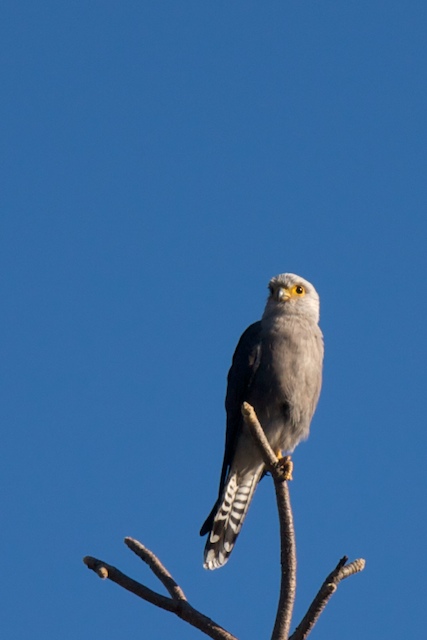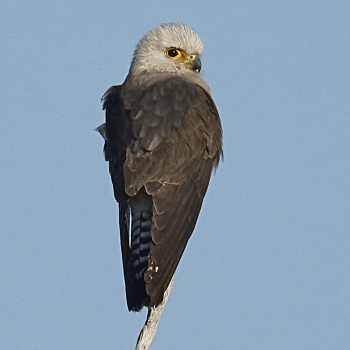- Falco dickinsoni
Identification
27-30cm (10½-11¾ in)
- Dark grey plumage
- Pale head and rump
- Grey, narrow black barred tail with broad subterminal band
- Barred underside of flight feathers
- Yellow cere
- Bare yellow eye skin
- Brown iris
- Dark grey bill
Female larger than the male Juvenile
- Grey brown
- Barred flanks
- Green cere and eyering
Distribution
Sub-Saharan Africa. Southern Tanzania including Pemba, south to northern South Africa and west to southern Angola. Resident.
Taxonomy
This is a monotypic species[1].
Habitat
Low-lying wooded savanna and cultivated land, particularly in floodplains.
Behaviour
Diet
The diet consists mainly of small birds, chameleons, grasshoppers, lizards, amphibians, bats, rodents and snakes.
Breeding
Often nests in a scrape in Borassus palms. The 1-4 cream eggs, have reddish-brown markings and are incubated by the female for 30 days; the young fledge about 33-35 days later.
References
- Clements, J. F., T. S. Schulenberg, M. J. Iliff, D. Roberson, T. A. Fredericks, B. L. Sullivan, and C. L. Wood. 2016. The eBird/Clements checklist of birds of the world: v2016, with updates to August 2016. Downloaded from http://www.birds.cornell.edu/clementschecklist/download/
- Handbook of the Birds of the World Alive (retrieved August 2017)
- Wikipedia
Recommended Citation
- BirdForum Opus contributors. (2025) Dickinson's Kestrel. In: BirdForum, the forum for wild birds and birding. Retrieved 1 May 2025 from https://www.birdforum.net/opus/Dickinson%27s_Kestrel





